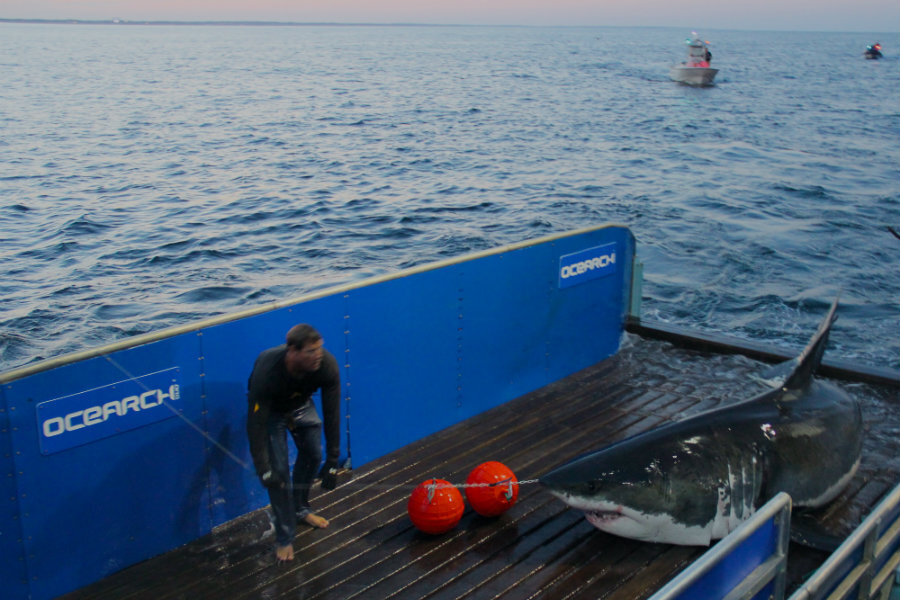How social media can make sharks seem less scary
Loading...
Attention, shark lovers: Mary Lee is back in town.
On Wednesday morning, a tracker attached to the 3,500-pound great white by the nonprofit research organization OCEARCH emitted a signal that placed her off the coast of Maryland. Mary Lee is one of at least 40 sharks worldwide that OCEARCH tracks in an effort to generate better data about sharks, and to promote public understanding and conservation of the endangered ocean predator.
The Smart Position and Temperature, or SPOT, tags that OCEARCH scientists and their partners place on sharks help them track the animals’ movements and behavior in a way never before documented, says OCEARCH president Chris Berger.
The data collected can be used to learn what sharks do, where they go, and where they breed, Mr. Berger says. With that information, leaders and experts can develop policies surrounding conservation, protection, and education.
“The ultimate goal is to replace fear with fascination and curiosity,” he says.
Unfounded fears
Despite humans’ often deep-seated fear of sharks, the fact is that people pose a far greater threat to sharks than the other way around. The odds of dying from a shark attack are about 1 in 3,700,000 — far lower than even the odds fatal lightning strike. By contrast, humans kill an estimated 100 million sharks a year.
“The number one myth is that all sharks are out to get us, and that's simply not true,” George Burgess, director of the Florida Program for Shark Research, told Business Insider. “There are more than 4,000 species of sharks worldwide and only a couple dozen probably are involved in shark bites historically. So most sharks have no interest whatsoever in biting a human.”
The shark’s modern reputation as man-eating monster, especially in the United States, likely came to be in 1916, just as Americans were beginning to go to the beach for leisure, said Washington Post environmental reporter Juliet Eilperin. That year, a series of shark attacks off the coast of New Jersey caused widespread panic, Ms. Eilperin explained at the 2012 South by Southwest eco conference. Media attention, as well as TV and films that demonized the great white, has since kept the fear alive.
It doesn’t help that sharks are not exactly cute and cuddly: “A set of shark teeth are among the most fearsome objects in nature and also among the finest of biological designs,” writes The Atlantic's Edward Tenner.
Building a community
For OCEARCH founder Chris Fischer, the best way to dispel the fear and mystery surrounding sharks — particularly great whites — is to create awareness and conversations around the facts, and in that manner forge understanding.
Mr. Fischer’s vision is the reason behind OCEARCH’s open-source approach, which means anyone with Internet access can look at the tracking data that the organization’s scientists and partners have collected over the years, Berger says.
Social media takes Fischer’s idea a step further, adds OCEARCH board member Peter Bordes, who is also CEO of social media marketing company oneQube. Mr. Bordes and the OCEARCH social media team have created “celebrity sharks” who, like Mary Lee, have their own Twitter accounts and engaged, caring communities.
“People talk about [the sharks], humanize them,” Bordes says. “It changes perceptions.”
The strategy also avoids the trap of social media campaigns that are based on single events such as Shark Week or World Oceans day, he adds, instead building a sustained, global network.
Not that there haven’t been challenges. Berger says the idea was, at first, a big risk to OCEARCH’s credibility.
“Any time you say you’re a science-driven organization and embrace the pop culture world, you get hammered,” he says.
But the organization has made progress, especially in the last year. Teachers, for instance, have begun to use the group’s data and curriculum guides to engage students in math and science, as well as in writing and communication.
Mary Kienstra, a teacher in the Naperville School District in Illinois, recently blogged about using data on the OCEARCH site to get her students to write non-fiction. They looked at shark vital statistics and migration patterns, as well as dug into broader concepts such as food chains and biodiversity.
It was the shark tracking interface that really got them engaged, she wrote.
“That was all it took for them to be totally absorbed in sharks,” Ms. Kienstra wrote. My students have taken complete ownership of their research as they track their very own shark. This is what curiosity in students looks like.”
For OCEARCH, Bordes and Berger say, Kienstra’s anecdote is a sign of real success.
“We want to use science to effect meaningful change, so that it becomes part of our everyday thinking and living,” Bordes says.






